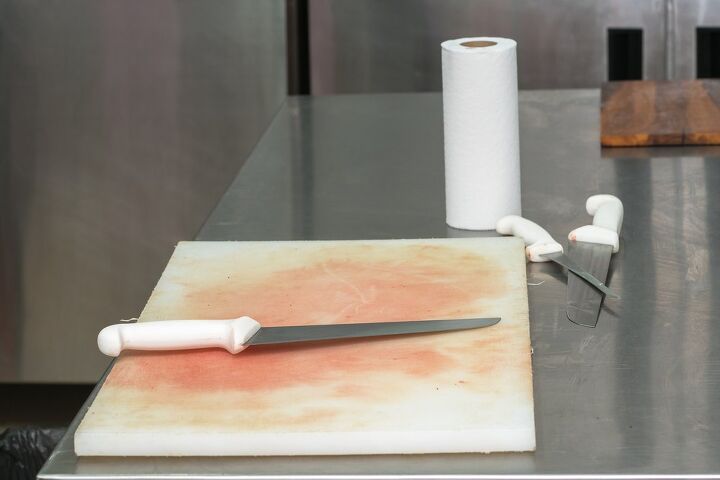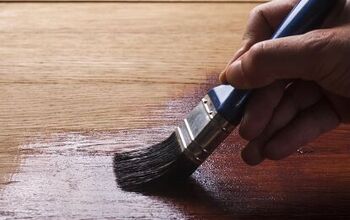Five Ways To Get Stains Off Of Cutting Boards

Cutting boards are an essential piece of kitchen equipment. Without them, knives would quickly become dull and countertops would deteriorate in a matter of days. There are various types of cutting boards, and they range in size, material, and price. Regardless of the type of cutting board you have, the last thing you want is a big food stain on your cutting board. So, if you find yourself with stubborn residue on your cutting board, you will want to find a reliable way to remove the stains.
To remove tough stains from your cutting board, apply baking soda or salt, then scrub the board while applying hot water or lemon juice. You can also use white vinegar or soapy hot water. Remember, plastic cutting boards and wood cutting boards have different care requirements. To prevent cutting board stains, clean your cutting board right away, and don’t let items sit long on the board.
A stained cutting board can be unsightly, and even unsanitary. The good news is even stubborn stains can be scrubbed or lifted from your cutting board. The key is knowing the best way to remove these stains, and how to prevent them from occurring in the first place. Keep reading to learn about some highly effective ways to remove stains from your cutting board and tips to help prevent your boards from staining in the future.
Five Ways To Get Stains Off A Cutting Board
1. Use Soap And Hot Water To Remove Cutting Board Stains
The first method you should try to remove stains from your cutting board involves your kitchen sponge, soap, hot water, and elbow grease. Use the same method you would use to wash your other dishes, only apply extra effort to the stained area.
If you notice the stain starting to diminish, then keep scrubbing the area. Make sure you don’t use an abrasive sponge, especially on nice wood cutting boards, as it can scratch and damage the board. If the stain is too stubborn, move on to another method.
2. Use Vinegar To Remove Cutting Board Stains
Vinegar is a great natural stain lifter, making it a great choice for those trying to remove cutting board stains. You don’t want to use any toxic cleaners on your cutting surfaces, so vinegar is a great liquid to try.
To remove stains from your cutting board using vinegar, you can use a spray bottle or clean rag to apply vinegar to the stained area. Vinegar also helps remove harmful bacteria, making it a great cleaning agent.
For best results, first sprinkle baking soda on the stained area, and then apply vinegar. You will notice a bubbling reaction. Allow this mixture to sit for five minutes, then scrub and wash away.
3. Use Lemon Juice And Salt To Remove Cutting Board Stains
You can also use lemon and salt to remove stains from your cutting board. One great benefit to this method is that lemons and salt are two common cooking ingredients that most people have on hand.
First, sprinkle the salt onto the stained area. Next, add lemon juice, or squeeze half a lemon onto the salt. The acid from the lemon and the coarseness of the salt act as a strong scrub that can help lift many cutting board stains. You can even use the lemon half as a scrubber to work the acid into the stained area.
4. Use Baking Soda To Remove Cutting Board Stains
Baking soda works great with vinegar (and even lemon juice) to remove stains, but you can also use it on its own with some hot water to lift cutting board stains. Baking soda is used in toothpaste and laundry detergent and is a proven stain lifter and whitener. So, it should come as no surprise that it is a good natural remedy for stained cutting boards.
First, clean the cutting board with soap and water, and then dry it. Sprinkle a healthy amount of baking soda on the stained area, then sprinkle hot water (or lemon juice or vinegar for extra punch), and let it sit for five minutes. Scrub the area thoroughly and then wipe it away.
5. Use Cleaning Products To Remove Cutting Board Stains
If you have a plastic cutting board, you can use stronger cleaning products to remove the most stubborn stains. You can spray bleach or other stain lifters, allow them to sit, and rinse away. Repeat this process until the stain is gone. Make sure you run a cutting board through the dishwasher after using strong chemicals like bleach to ensure the chemicals are completely removed.
Do not use bleach or other harmful cleaners on wooden cutting boards. These chemicals can seep into the wood, which can then make its way to your food, and can also damage the cutting board.
Four Ways To Prevent Your Cutting Board From Staining
1. Clean The Board Immediately After Use
The best way to prevent stains from happening is to diligently clean your cutting boards after each use. Don’t just toss your cutting board into the sink. If you don’t have time to wash it thoroughly right away, at least rinse it off and give it a quick soak.
2. Don’t Cut Foods That Cause Stains On Your Good Board
If you are planning on cutting roasted beets, strawberries, or other foods that stain easily, try to remember to use a cheap plastic cutting board. Avoid using your best wooden and natural fiber cutting boards when cutting products that stain easily.
3. Don’t Let Ingredients Sit On The Board
Remember that your cutting boards are for cutting, not food storage. Once you cut items, place them in bowls or containers. If you leave juicy items like pomegranates or berries on your cutting board, stains can slowly seep deep into the cutting board.
4. Add A Layer Of Vegetable Oil To Board Before Cutting
One fun trick to prevent stains is to add a thin layer of vegetable oil. Oil and water are enemies, and many stains are water-based. A thin layer of oil acts as a barrier between your board and the stain-causing liquid.
What Not To Do When Your Cutting Board Is Stained
Don’t Let A Wood Cutting Board Soak Overnight
Many people like to soak pots and pans overnight to loosen stains and grime. Don’t do this with wooden cutting boards or wooden cutlery. Wood and bamboo cutting boards can warp if soaked too often. It can cause the wood to soften, and even grow mold. Only soak plastic cutting boards for long periods.
Don’t Use Toxic Chemicals
Never use strong chemicals on wood or other porous materials. Toxic chemicals should also be a last resort when cleaning plastic cutting boards. Remember to rinse and wash thoroughly after using strong cleaning products on your plastic cutting boards.
Don’t Use A Course Scrub Brush On Delicate Wood
Sometimes to lift stains you need to do some scrubbing. Just remember not to use a very harsh scrub brush or steel wool. This is especially true when you are trying to lift stains off a wood cutting board. Abrasive scrubbers can cause scratches and discoloration that can make your cutting board look even worse and even render it unusable.
Final Thoughts About How To Get Stains Off A Cutting Board
If you notice a stain on your favorite cutting board, don’t panic. Cutting board stains can be stubborn, but there are several ways to get rid of them. Try using a combination of vinegar and baking soda on the stain, or salt and lemon. Allow the products to sit for five minutes before scrubbing. Avoid using strong chemicals on porous boards, and remember to wash your cutting board quickly after each use to avoid stains in the future.
Related Guides:

Tom Gaffey is an expert writer who currently resides in Washington D.C. Tom has a passion for real estate and home improvement writing, as well as travel and lifestyle writing. He lived the last twelve years in Hawaii where he worked closely with luxury resorts and event planners, mastering his knowledge of aesthetics and luxury products. This is where he found his passion for home improvement and a keen interest in DIY projects. Currently, Tom resides in Washington D.C, and also working on his debut fiction novel.
More by Tom Gaffey














![The 5 Best Angle Grinders – [2022 Reviews & Buyer's Guide]](https://cdn-fastly.upgradedhome.com/media/2023/07/31/9071326/the-5-best-angle-grinders-2022-reviews-buyer-s-guide.jpg?size=350x220)







![Cost To Drill A Well [Pricing Per Foot & Cost By State]](https://cdn-fastly.upgradedhome.com/media/2023/07/31/9074980/cost-to-drill-a-well-pricing-per-foot-cost-by-state.jpg?size=350x220)




